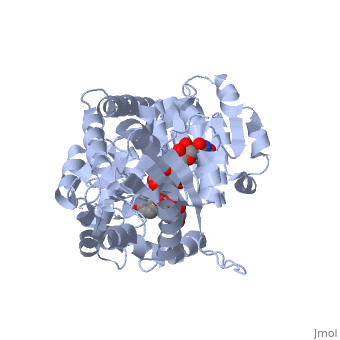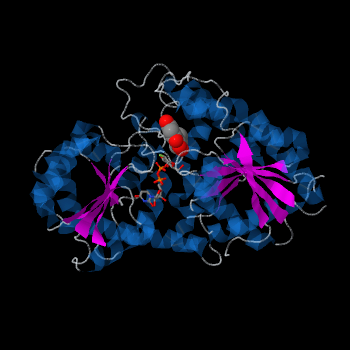Vitis vinifera Flavonoid 3-O-Glucosyltransferase (Vv3GT)
From Proteopedia
| Line 1: | Line 1: | ||
<StructureSection load='2c1z' size='340' side='right' caption='Caption for this structure' scene=''> | <StructureSection load='2c1z' size='340' side='right' caption='Caption for this structure' scene=''> | ||
| - | Vitis vinifera Flavonoid 3-O-Glucosyltransferase (Vv3GT) is involved in the modification of grape anthocyanins (a plant pigment) and thus could affect their water solubility and color stability. | + | Vitis vinifera Flavonoid 3-O-Glucosyltransferase (Vv3GT) is involved in the modification of grape anthocyanins (a plant pigment) and thus could affect their water solubility and color stability. The addition of a sugar molecule on the anthocyanin is a preliminary step to its transport to the cell vacuole. The transfer to the vacuole is important for the pigment accumulation. The anthocyanin accumulation plays a significant role in quality of agricultural produce, as it affects fruit color and its health benefits as a natural antioxidant. This enzyme affects the quality of both table grapes and wine grapes. |
== Introduction == | == Introduction == | ||
| - | Vv3GT belongs to Glycosyltransferases (GTs), a large family of enzymes involved in the transfer of sugar residues from a sugar donor to various substrates. Glycosylation of metabolites in plants is usually catalyzed by glycosyltransferases (GTs) belonging to the GT1 sub-family (as classified by the CAZy database [http://www.cazy.org], which use UDP-activated sugars as the major donor molecule and are thus referred to as UGTs. | + | Vv3GT belongs to Glycosyltransferases (GTs), a large family of enzymes involved in the transfer of sugar residues from a sugar donor to various substrates. Glycosylation of metabolites in plants is usually catalyzed by glycosyltransferases (GTs) belonging to the GT1 sub-family (as classified by the CAZy database [http://www.cazy.org], which use UDP-activated sugars as the major donor molecule and are thus referred to as UGTs. The Glycosyltransferase activity is highly important for the synthesis of thousands of plant metabolites. This enzymes differ in their specificity for substrate, position of glycosylation on the substrate and recognition of sugar donor. These differences are important and could affect the function and stability of the metabolite. A good example for the importance of glycosyltransferase specificity is shown in Citrus. the difference in the position of glycosylation affects fruit flavor. Glycosylation of one position lids to the synthesis of bitter substances while the addition of same molecule at a different position lids to the synthesis of tasteless substances. |
| Line 40: | Line 40: | ||
== References == | == References == | ||
| - | 1. | + | 1. Frydman A, Weisshaus O, Bar-Peled M, Huhman DV, Sumner LW, Marin FR, Lewinsohn E, Fluhr R, Gressel J and Eyal Y (2004) Citrus fruit bitter flavors: Isolation and functional characterization of the gene Cm1,2RhaT encoding a 1,2 rhamnosyltransferase, a key enzyme in the biosynthesis of the bitter flavonoids of citrus. Plant J. 40: 88-100. |
| - | 2. Osmani SA, Bak S, Møller BL (2009) Substrate specificity of plant UDP-dependent glycosyltransferases predicted from crystal structures and homology modeling. Phytochemistry 70: 325-347. | + | 2. Offen W, Martinez-Fleites C, Yang M, Lim EK, Davis BG, Tarling CA, Ford CM, Bowles DJ, Davies GJ (2006) Structure of a flavonoid glucosyltransferase reveals the basis for plant natural product modification. EMBO 25: 1396-1405. |
| + | |||
| + | 3. Osmani SA, Bak S, Møller BL (2009) Substrate specificity of plant UDP-dependent glycosyltransferases predicted from crystal structures and homology modeling. Phytochemistry 70: 325-347. | ||
Revision as of 09:39, 25 January 2015
| |||||||||||
References
1. Frydman A, Weisshaus O, Bar-Peled M, Huhman DV, Sumner LW, Marin FR, Lewinsohn E, Fluhr R, Gressel J and Eyal Y (2004) Citrus fruit bitter flavors: Isolation and functional characterization of the gene Cm1,2RhaT encoding a 1,2 rhamnosyltransferase, a key enzyme in the biosynthesis of the bitter flavonoids of citrus. Plant J. 40: 88-100.
2. Offen W, Martinez-Fleites C, Yang M, Lim EK, Davis BG, Tarling CA, Ford CM, Bowles DJ, Davies GJ (2006) Structure of a flavonoid glucosyltransferase reveals the basis for plant natural product modification. EMBO 25: 1396-1405.
3. Osmani SA, Bak S, Møller BL (2009) Substrate specificity of plant UDP-dependent glycosyltransferases predicted from crystal structures and homology modeling. Phytochemistry 70: 325-347.


